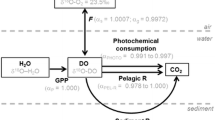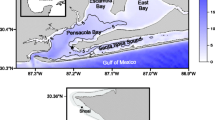Abstract
Estimates of net primary production, community respiration (R'), and gross primary production (P g) are developed and presented for the productive layers of eutrophic Onondaga Lake, NY, U.S.A., for time scales ranging from diel to several months, based on 4 months of robotic diel profiles of dissolved oxygen (DO) and temperature. Metabolic rate calculations are made through application of a DO mass balance framework that also accommodates inputs and losses of DO mediated by exchange across the air–water interface and across the lower boundary of the productive layers. It is demonstrated that the dynamics of the flux across the air–water interface are important to the metabolic rate estimates, while vertical mixing-based losses to the underlying layers can be ignored. Study average estimates of R' (1.49 g O2 m−3 d−1) and P g (1.60 g O2 m−3 d−1) obtained by this non-isolated community approach are consistent with levels reported in the literature for similar chlorophyll a concentrations, based on isolated community (bottle experiment) protocols to measure these metabolic rates. The non-isolated community approach is shown to have limited utility for quantifying day-to-day changes in these rates in this lake, apparently because of horizontal exchange with waters of different DO concentrations. However, this approach may support reliable estimates of metabolic rates at intermediate time scales; e.g., several days to a week. The DO mass balance framework is demonstrated to be valuable in resolving the relative roles of various physical and biological processes in regulating the DO pool of the productive layers.
Similar content being viewed by others
References
Addess, J. M. & S. W. Effler, 1996. Summer methane fluxes and fall oxygen resources of Onondaga Lake, New York. Lake and Reserv. Manage. 12: 91–101.
Bella, D. A., 1970. Dissolved oxygen variations in stratified lakes. J. Sanitary Engrg. Div. ASCE 96: 1129–1146.
Bretts, K. S., 1998. Technology Update–All-weather water quality monitor. Environ. Sci. Technol. 32: 85
Camarero, L. & J. Catalan, 1991. Horizontal heterogeneity of phytoplankton in a small high mountain lake. Verh. int. Ver. Limnol. 24: 1005–1010.
Chapra, S. C. & D. M. DiToro, 1991. Delta method for estimating primary production, respiration and reaeration in streams. J.Environ. Engrg. Div. ASCE 117: 640–655.
del Giorgio, P. A. & R. H. Peters, 1993. Balance between phytoplankton production and plankton respiration in lakes. Can. J. Fish. aquat. Sci. 50: 282–289.
Doerr, S. M., R. P. Canale & S. W. Effler, 1996. Development and testing of a total phosphorus model for Onondaga Lake, NY. Lake and Reserv. Manage. 12: 141–150.
Effler, S. W., 1996. Limnological and Engineering Analysis of a Polluted Urban Lake. Prelude to Environmental Management of Onondaga Lake, New York. Springer-Verlag, New York, NY: 832 pp.
Effler, S. W., C. M. Brooks & K. A. Whitehead, 1996. Domestic waste inputs of nitrogen and phosphorus to Onondaga Lake, and water quality implications. Lake and Reserv. Manage. 12: 127–140.
Effler, S. W. & E. M. Owens, 1996. Density stratification in Onondaga Lake: 1968–1994. Lake and Reserv. Manage. 12: 25–33.
Effler, S.W. & M. G. Perkins, 1996. An optics model for Onondaga Lake. Lake and Reserv. Manage. 12: 115–125.
Gelda, R. K. & M. T. Auer, 1996. Development and testing of a dissolved oxygen model for a hypereutrophic lake. Lake and Reserv. Manage. 12: 165–179.
Gelda, R. K., M. T. Auer, S. W. Effler, S. C. Chapra & M. L. Storey, 1996. Determination of reaeration coefficients: A whole lake approach. J. Environ. Engrg. Div. ASCE 122: 269–275.
Gelda, R. K. & S. W. Effler, 2002. Estimating oxygen exchange across the air–water interface of a hypereutrophic lake. Hydrobiologia (in press).
Gelda, R. K., S. W. Effler & S. M. O'Donnell, 2001. Probabilistic model of ammonia and toxicity status for urban lake. J. Water Res. Plan. Manage. 127: 337–347.
George, D. E. & S. I. Heaney, 1978. Factors influencing the spatial distribution of phytoplankton in a small productive lake. J. Ecol. 66: 133–155.
Jassby, A. & T. M. Powell, 1975. Vertical patterns of eddy diffusion during stratification in Castle Lake, California. Limnol. Oceanogr. 20: 530–543.
Jones, R. I., A. S. Fulcher, J. K. U. Jayakody, J. Laybourn-Parry, A. J. Shine, M. C. Walton & J. M. Young, 1995. The horizontal distribution of plankton in a deep, oligotrohic lake–Loch Ness, Scotland. Freshwat. Biol. 33: 161–170.
Lampert, W., W. Fleckner, H. Rai & B. E. Taylor, 1986. Phytoplankton control by grazing zooplankton: A study on the spring clear-water phase. Limnol. Oceanogr. 31: 478–490.
Laws, E. A. & M. S. Chalup, 1990. A microbial growth model. Limnol. Oceanogr. 35: 597–608.
Lingeman, R. & S. Vermij, 1980. Estimation of primary productivity in aquatic systems using free oxygen measurements. Wat. Resour. Bull. 16: 745–748.
Madsen, J. D., J. A. Bloomfield, J. W. Sutherland, L. W. Eichler & C. W. Boylen, 1996. The aquatic macrophyte community of Onondaga Lake: Field survey and plant growth bioassays of lake Sediments. Lake and Reserv. Manage. 12: 73–79.
Martin, J. L. & S. C. McCutcheon, 1999. Hydrodynamics and transport for water quality modeling. Lewis Publishers, Boca Raton, FL: 794 pp.
Matthews, D. A., S. W. Effler, C. M. Matthews (Brooks), C. A. Siegfried & M. E. Spada, 2001. Responses to early stages of rehabilitation: Onondaga Lake, NY. Wat. Environ. Res. 73: 691–703.
Meffert, M.-E. & J. Overbeck, 1985. Dynamics of chlorophyll and photosynthesis in natural phytoplankton associations. II. Primary productivity, quantum yields and photosynthetic rates in small North-German lakes. Arch. Hydrobiol. 104: 363–385.
O'Connor, D. J., 1983. Wind effects on gas–liquid transfer coeffi-cients. J. Environ. Engrg. Div. ASCE 109: 731–752.
Odum, H. T., 1956. Primary production in flowing waters. Limnol. Oceanogr. 1: 102–117.
Owens, E. M. & S. W. Effler, 1989. Changes in stratification in Onondaga Lake, NY. Wat. Resour. Bull. 25: 587–597.
Owens, E. M. & S. W. Effler, 1996. Modeling the impacts of a proposed hypolimnetic wastewater discharge on stratification and mixing in Onondaga Lake. Lake and Reserv. Manage. 12: 195–206.
Parsons, T. R., Y. Maita & C.M. Lalli, 1984. A Manual of Chemical and Biological Methods for Seawater Analysis. Pergamon Press, New York, NY.
Perkins, M. G. & S. W. Effler, 1996. Optical characteristics of Onondaga Lake 1968–1990. Lake and Reserv. Manage. 12: 103–113.
Portielje, R. & L. Lijklema, 1995. Carbon dioxide fluxes across the air–water interface and its impact on carbon availability in aquatic systems. Limnol. Oceanogr. 40: 690–699.
Rowell, C., 1996. Paleolimnology of Onondaga Lake: The history of anthropogenic impacts on lake water quality. Lake and Reserv. Manage. 12: 35–45.
Schwaerter, S., M. Søndergaard, B. Riemann & M. J. Jensen, 1988. Respiration in eutrophic lakes: the contribution of bacterioplankton and bacterial growth yield. J. Plankton Res. 10: 515–531.
Vollenweider, R. A., 1974. A Manual on Methods for Measuring Primary Production in Aquatic Environments, 2nd edn. IBP Handbook No. 12. Blackwell Scientific, Oxford, U.K.: 225 pp.
Wanninkhof, R., J. R. Leduidl & J. Crusius, 1991. Gas transfer velocities on lakes measured with sulfur hexafluoride. InWilhelms S. C. & J. S. Gulliver (eds), Air Water Mass Transfer. Symposium Volume of the Second International Conference on Gas Transfer at Water Surfaces, Minneapolis, MN.
Wetzel, R. G., 2001. Limnology: Lake and Reservoir Ecosystems. Academic Press, New York: 1006 pp.
Wetzel, R. G. & G. E. Likens, 2000. Limnological Analysis, 3rd edn. Springer-Verlag, New York: 429 pp.
Wodka, M. C., S. W. Effler, C. T. Driscoll, S. D. Field & S. D. Devan, 1983. Diffusivity-based flux of phosphorus in Onondaga Lake. J. Environ. Engrg. Div. ASCE 109: 1403–1415.
Author information
Authors and Affiliations
Rights and permissions
About this article
Cite this article
Gelda, R.K., Effler, S.W. Metabolic rate estimates for a eutrophic lake from diel dissolved oxygen signals. Hydrobiologia 485, 51–66 (2002). https://doi.org/10.1023/A:1021327610570
Issue Date:
DOI: https://doi.org/10.1023/A:1021327610570




